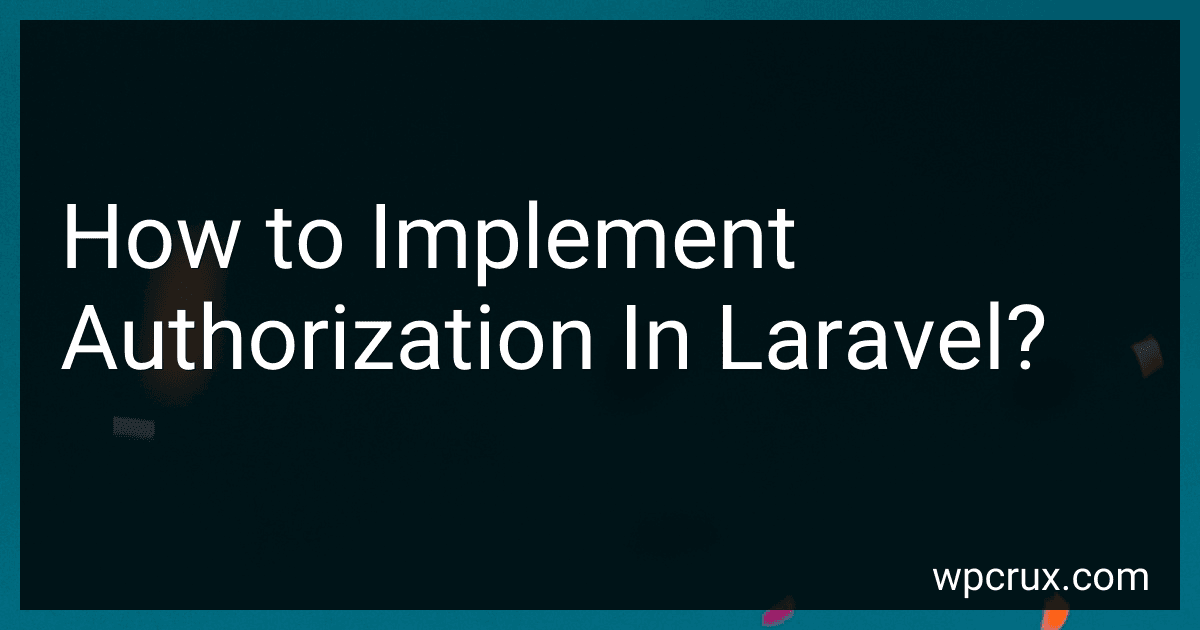Best Laravel Authorization Tools to Buy in October 2025
To implement authorization in Laravel, you can follow these steps:
- Setting up the Database: Create a database table to store user roles and permissions. Define the relationships between roles, permissions, and users.
- Configuring the Application: Define gates and policies in the Laravel authorization configuration file (config/auth.php). Specify which models should use authorization by implementing the Illuminate\Contracts\Auth\Access\Authorizable contract.
- Defining Gates: Gates determine if a user has the ability to perform a specific action. Define various gates in the App\Providers\AuthServiceProvider class using the Gate facade. Gate definitions usually include a callback function that checks if the user has the necessary permissions.
- Defining Policies: Policies are classes that define authorization logic for specific models or resources. Create policy classes using the php artisan make:policy command. Define methods in the policy class that correspond to the actions you want to authorize (e.g., view, create, delete).
- Registering Policies: Register the created policies in the AuthServiceProvider class by associating them with their respective models or resources. Use the Gate facade to call the policy method, passing the target model and its associated policy.
- Authorizing Actions: Use policy-based authorization to determine if a user is authorized to perform specific actions on a model. In your controller or route, use the authorize method provided by the AuthorizesRequests trait to enforce authorization checks.
- Enforcing Policies: Use the can middleware to authenticate and authorize routes or API endpoints. Apply the can middleware to specific routes or groups of routes in your web.php or api.php route files.
- Using Authorization in Views: In your views, you can check if a user has permission to perform a specific action using the @can Blade directive. Surround the content you want to show or hide with the @can and @endcan directives.
These steps will help you implement authorization in Laravel using gates and policies, allowing you to control access to different parts of your application based on roles and permissions.
How to implement authorization at the view level in Laravel?
To implement authorization at the view level in Laravel, you can follow these steps:
- Define your authorization rules: Determine the rules and permissions you want to enforce at the view level. For example, you may want to restrict access to certain views based on user roles or permissions.
- Create an authorization policy: Laravel uses policies to define authorization rules for model instances. To create a new policy, you can run the following artisan command:
php artisan make:policy AuthorizationPolicy
This will generate a new policy file in the app/Policies directory.
- Define authorization methods in the policy: Open the generated policy file (AuthorizationPolicy) and define authorization methods that correspond to your defined rules. For example, you can create a method called viewDashboard to determine if a user is authorized to view the dashboard.
public function viewDashboard(User $user) { // Check if the user has the necessary roles or permissions to view the dashboard return $user->hasRole('admin') || $user->can('view-dashboard'); }
- Register the policy: In the AuthServiceProvider (app/Providers/AuthServiceProvider.php) file, you need to register the policy by associating it with the corresponding model or resource. For example, if you want to associate the policy with the Dashboard model, you can add the following code to the boot method:
use App\Models\Dashboard; use App\Policies\AuthorizationPolicy;
public function boot() { $this->registerPolicies();
Gate::resource('dashboard', AuthorizationPolicy::class);
}
- Use the @can directive in views: In your views, you can use the @can directive to conditionally render content based on the user's authorization. For example, to show a dashboard link only to authorized users, you can use the @can directive as follows:
@can('view', App\Models\Dashboard::class) Dashboard @endcan
- Protect routes: Finally, you can also protect routes using the can method in your route definitions to ensure that only authorized users can access certain routes. For example, to protect the dashboard route, you can modify your route definition in the web.php file:
Route::get('/dashboard', [DashboardController::class, 'index']) ->middleware('can:view,App\Models\Dashboard');
With these steps, you have implemented authorization at the view level in Laravel by defining authorization rules, creating a policy, registering it, and using the @can directive in your views.
How to authorize controller actions in Laravel?
In Laravel, you can use middleware to authorize controller actions. Middleware allows you to filter HTTP requests easily, and it can be used to perform authorization checks before allowing the request to proceed to the controller action.
To authorize controller actions in Laravel, you can follow these steps:
- Create a new middleware by running the following command in your terminal:
php artisan make:middleware Authorize
- Open the newly created App/Http/Middleware/Authorize.php file and implement your authorization logic in the handle() method. Here's an example:
